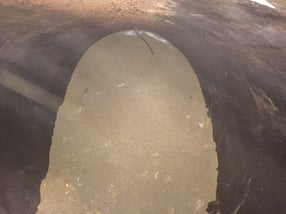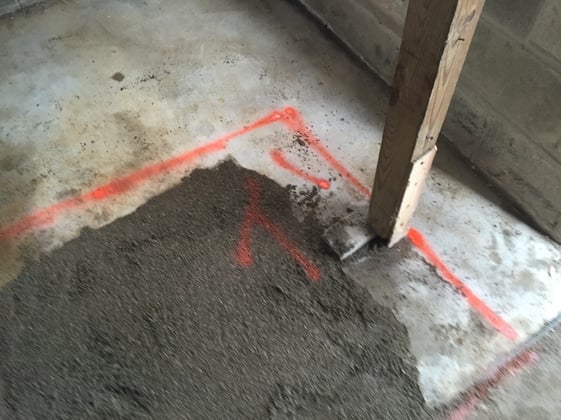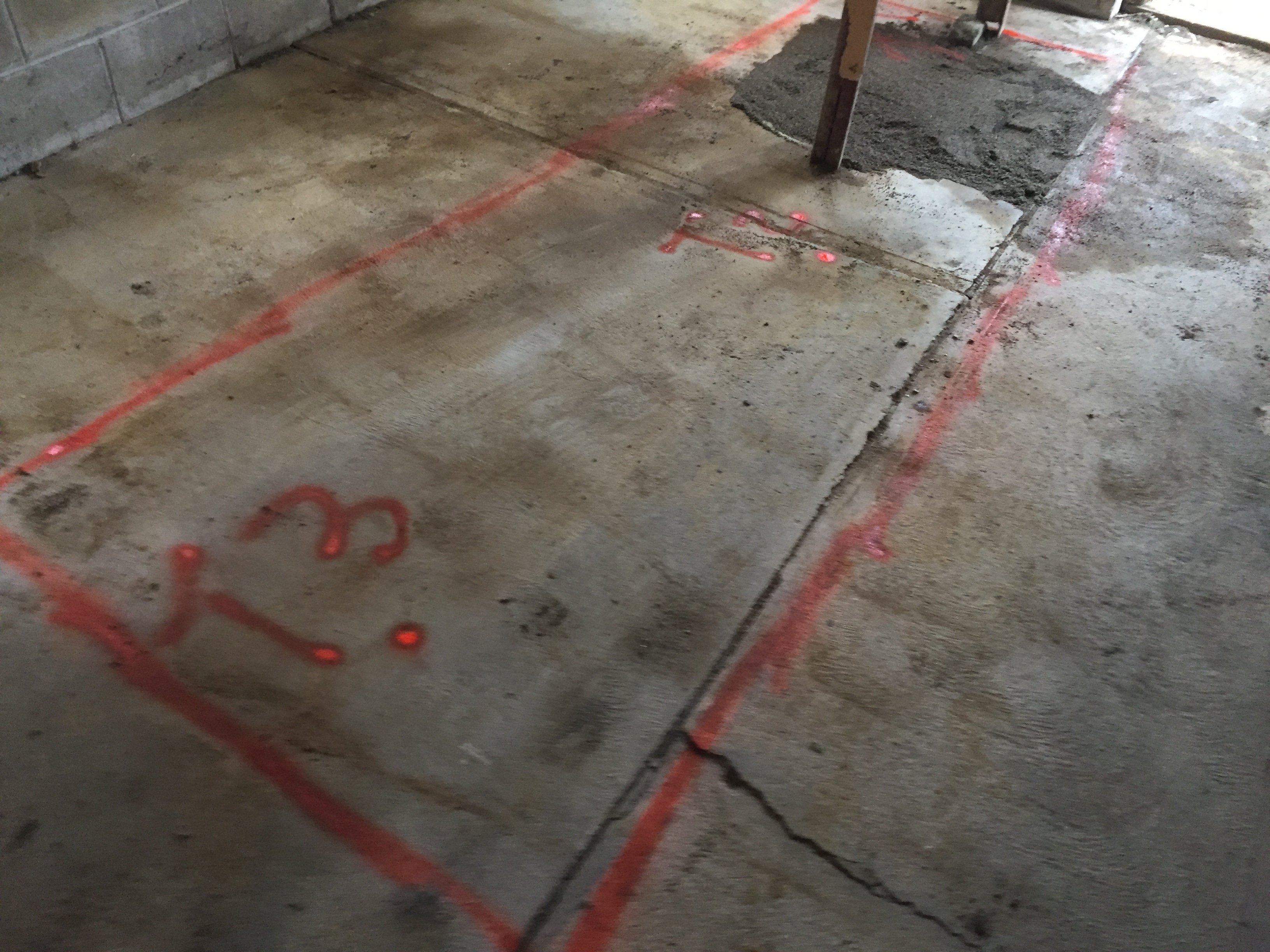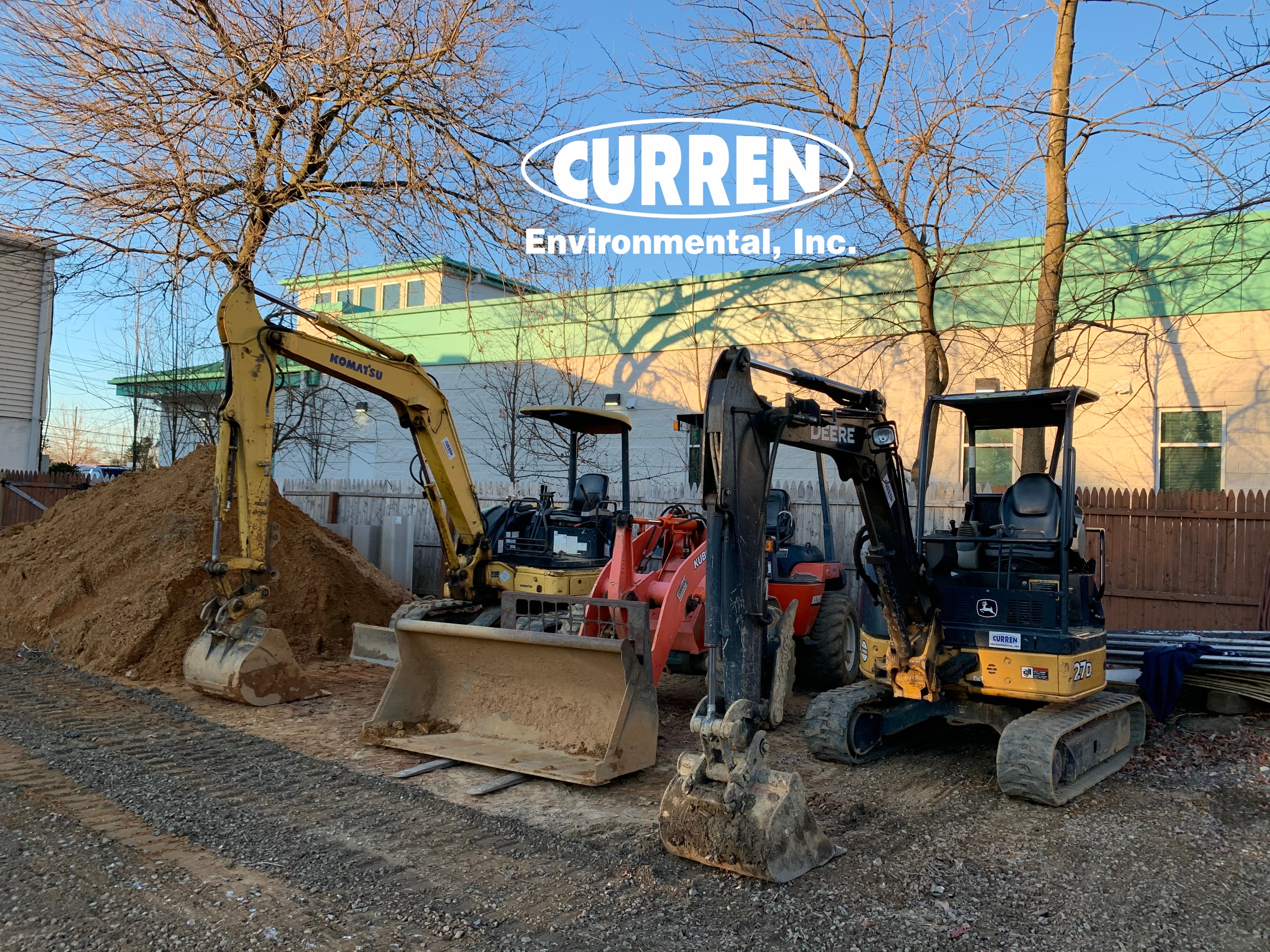Tank Abandonment
aka (Tank Closure in Place)
Ok let me start off with the fact that buried metal tanks rust and leak petroleum that the owner of the property has to pay to cleanup. So, the concern with any tank is if it leaked.


Obviously removing a tank best solves the potential for a tank to leak, but SOMETIMES removal is going to be excessively expensive. Like when a building is on top of the tank. Like the photo below.
Pro T
Pro Tip
Environmental regulations for commercial tanks in Delaware, Pennsylvania & New Jersey (the 3 states Curren is licensed in) allow a tank to be closed in place BUT you have to cut holes in the tank and tank soil samples before you fill the tank in place. This is because the states require you to document if the tank did or did not leak.
The photos below show we cut "coupons" through the tank shell to acquire soil samples.

.jpg?width=318&height=239&name=Photo%20Jul%2020%2c%2011%2052%2047%20AM%20(1).jpg)
Curren recommends that in all cases where it is feasible, the underground storage tank be removed. While this approach is recommended, we know from experience that removal is not always feasible. Tanks can be located under decks, beneath patios, in basements, crawl spaces and beneath additions. In general, some tanks were buried without regard to having the tank removed in the future. You may also find that utilities were placed on top of or across the tank. Natural gas lines are very common to run on top of or adjacent to buried tanks. In certain cases, tank removal is prohibitive (expensive). In these cases, a tank closure in place is the preferred option.
So how do you properly abandon a tank in place. This can also read if you have a tank that was filled in place do you have documentation that the following steps were followed?
Questions?
Environmental Managers are available Monday to Friday from 8:00am to 5:00 pm EST.
The procedures followed to fill a tank in place are as follows:
Step 1: Local Permits
Before any tank closure work can be performed; a permit to abandon the underground tank will be obtained from the local municipality, fire department, health department, or other applicable agency. There are some municipalities in Delaware and Pennsylvania that do not require permits, this would be in more rural areas, but 100% of the time you have to make sure permits are or are not required. 97% of the time they are.
Step 2: Excavation requires a utility markout
All states require you obtain a public utility mark out to ensure you do not hit a buried utility. It is required by law and the fine is several thousand dollars if you don't.
Yes you have to dig up a portion of the tank because you have to go inside the tank to clean it. You can't leave any residue. Typically, you dig an area 3' by 3' but it really depends on how deep the tank is buried. The photo below is a good example of the area required to expose the tank.

Step 3: Liquid Disposal & Cleaning
Next you extract remaining oil from the tank then cut a hole in the top of the tank so a person can go inside and extract remaining liquid and sludge. To make sure the tank has breathable air you the purge petroleum vapors from inside the tank and continuous monitor the atmosphere of the tank. If no flammable vapors are present and the tank contains sufficient Oxygen, the tank will be entered and cleaned. American Petroleum Institute Publication 2015, "Cleaning Petroleum Storage Tanks," procedures will be followed throughout this phase of the project. API is the standard on how you safely and effectively enter and clean a tank. Tank cleaning will consist of wiping, squeegeeing, and removing all liquids and sludge from the tank.


Step 4 Soil Sampling
What does everyone want to know about an oil tank? People want to know if the tank leaked. Leaking tanks cost money to cleanup. The way you know a tank did not leak is by obtaining soil sampling. When a tank is being abandoned in place, how do you obtain soil samples from below a steel tank?
You can cut holes or the industry term cut coupons in the bottom of the tank so you can access soils below the tank and obtain your samples. This practice has been followed for over 20 years, the problem is many tanks never had the testing performed when the tank was filled in place. These cases dictate that you reverse engineer the prior tank removal by removing all the prior fill installed, you reclean the tank, cut coupons and obtain soil samples. If you want to learn about how to manage a tank that was previously abandoned in place click this link: Tanks Previously Abandoned in Place

Step 5 Local Inspection
Remember the permit you got to abandon the tank in place, well a local inspector will visit the site to verify you did the work. They typically want to see the cleaned tank and return to see you backfilled and restore the area. Now please understand this, you got a permit to abandon a tank in place and that is what the inspection is. The local official is NOT CERTIFYING THE TANK DID NOT LEAK. Got it, your certification for not leaking is the soil sampling and the REPORT OF CLOSURE Step 7
Step 6: Tank Filling
Ok you made it this far. You cleaned the tank, you took soil samples, no leaks all looks good. So now you have to fill the tank void. Regulations require that the tank void be filled with an inert material which can be soil, concrete slurry or foam. Each has its advantages. Pertaining to foam filling, foam tends to be able to be installed in a tank when access is an issue and when future removal maybe a possibility foam is white in color and is classified as an inert nonflammable material. More about foam tank filling here: Foam Tank Filling The foam is mixed on site to the quantity needed to fill the tank void (volume). The photo below shows one of Curren's foam trailers.


The foam is installed utilizing a wand similar to a power washer wand. The hose utilized to transfer the foam can be snaked several hundred feet around corners and downstairs to the tank location.

Foam has superior advantages to reach areas where sand or concrete cannot.
Sand, stone and concrete slurry can also be used to fill a tank void.


Backfilling will also include restoring the surface you excavated to access the tank. The photo below shows the concrete floor has been repaired.


Step 7: Tank Closure Report
Seven steps you have gone through to abandon the tan, each is important BUT the most important is the report of the work
This report details what was done and the professional findings. To make it simple I am including text from a report, that you should be expected to have in any report documenting a tank abandoned in place or even one that is removed.
This summary of findings was prepared by Curren Environmental, Inc. (Curren) to document the Underground Storage Tank (UST) closure and site assessment activities conducted at the residential property located at XXXXXXXXXXXX. The tank associated with the property was a 290-gallon #2 fuel oil UST that was present under landscaping adjacent to the concrete sidewalk and residence. The tank was being removed for a future real estate transaction. Site photographs which depict the UST location are included in the List of Attachments.
Prior to mobilizing to the subject site, Curren submitted a permit application and obtained a construction permit from the Township of XXXXXX for the removal of the subject UST (Permit #: XXXXXX).
On November 2, 2022, Curren mobilized equipment and labor to remove the subject 290-gallon #2 fuel oil UST (subject tank). The tank was located under landscaping adjacent to the concrete sidewalk and residence. The area above the subject tank was excavated to expose the top of the tank, and a hole was cut into the top for access. One man entered the tank and performed the cleaning procedures. The remaining sludge was scraped and removed; and the tank was thoroughly wiped clean and dried.
Five (5) soil samples (T1 through T5) were acquired by Curren personnel from beneath the UST location at an approximate depth of 6-6.5’ below grade surface (b.g.s.). Based on the onsite observations, only two soil samples were analyzed. Laboratory analysis of the soil sample indicated Extractable Petroleum Hydrocarbon (EPH) concentrations were non-detect (ND) in both soil samples.
After inspection by a representative of the Township of XXXXX and the subject tank was filled in place with approximately 1.5 yards of clean fill and the remainder of the excavation backfilled with the previously excavated overburden soils. A copy of the liquid recycling receipt associated with the tank closure is included in the List of Attachments.
A copy of the clean fill certification is included in the List of Attachments.
Conclusions & Recommendations
- Based on physical observations made during the tank closure activities, and confirmed by independent laboratory analysis, it does not appear a release has occurred associated with the subject 290-gallon #2 fuel oil UST. Due to the fact that the EPH concentrations were non-detect (ND) in both soil samples, no further remedial action is warranted.
Soil Sampling Site Assessment
aka
How do I know the tank abandoned in place didn't leak?
Many people believe that if you leave abandon in the ground you can't obtain soil samples to determine if the tank leaked. This is a false assumption as there are requirements for commercial tanks, which include obtaining soil samples even if a tank is abandoned in place. How this is performed is by cutting holes or as we say in the industry coupons in the bottom of the tank. This coupon clipping allows the soils below the tank to be obtained and placed into laboratory supplied glassware and submitted to a licensed laboratory for analysis. The photo below shows a triangle shaped coupon cut in the bottom of the tank.
Now there are many people who had their tanks filled in place and who did not obtain soil samples, either because they got bad advice from the removal company or they did not want to find a problem, or both. These tanks are a whole separate issue, which you can learn more about by clicking the following link:
In summary, most tanks can be removed for the same cost as abandoning a tank in place. These are sites that have a tank in an accessible location, which is the vast majority of tanks. Now there are situations where there are obstructions that hinder the physical removal of a tank. Maybe you could remove these tanks, but often times the math doesn't work, meaning it is just much more expensive to remove than abandoning the tank in place.
Curren recommends abandoning an underground storage tank in place when the tank is located under a building or would endanger a building structure if removed. It should be noted that some townships and municipalities may say they do not allow abandonment in-place. This is typically not the case as the town would have had to enact a statue or law, which takes time and money. Ask to see the regulation. If abandonment in-place is the only option, then soil sampling beneath the tank is highly recommended.
Pro Tip
What if a tank was abandoned, filled in place under grass in an easy to access area?
If you don't have a report, the tank gets removed. Most likely (based on 10,000's of tanks, people left the tank in place to avoid finding a problem. Don't believe the excuse that they didn't want to make a mess, grass can be replanted, mulch relaid, concrete repaired. Hey have you ever seen an inground pool being built? yards looks like a major construction site because you need to dig dirt out and bring concrete in. After pool install everything gets redone nice, same thing for a tank removal.
Still have question? Call Curren Today, we are licensed for tank work in Delaware, New Jersey and Pennsylvania,
over 20 years experience


